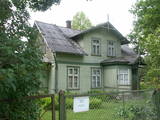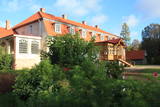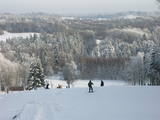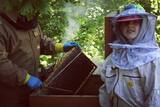| Nr | Nosaukums | Apraksts |
|---|---|---|
|
Skaistā, sakoptā un mākslinieciski iekārtotā viensēta atrodas Jaunpiebalgas pagastā. Viensēta iekļaujas apkārtējā ainavā, vecā kūts ir mūsdienīgi atjaunota un tās augšstāvā iekārtota saimnieces, kura ir tekstilmāksliniece, darbnīca un izstāžu zāle. Atjaunota arī veca guļbūve un no jauna uzbūvēta pirtiņa. Sētai cauri tek upīte, un teritorijā atrodas arī Tulejas pilskalns, kas ir valsts mēroga aizsargājamais dabas objekts. |
||
|
Ēdnīca "Sipres" atrodas uz Līvānu galvenās ielas. Piedāvā mājas virtuvi un latviskus ēdienus. Latviešu virtuve: kartupeļu pankūkas, aukstā zupa, grūbu un miežu biezputras, cūkas ribiņas ar skābiem kāpostiem, maizes zupa. Īpašais ēdiens: „Dubnas un Daugavas akmeņi” – kartupeļu klimpas ar biezpiena pildījumu krējuma mērcē. |
||
|
This itinerary allows you to enjoy the Latvian winter at its best. It starts in the bustling capital of Riga with its Christmas market, decorations, shopping facilities, many cultural events and museums as well as a charming Old Town. |
||
|
Atrodas Valmieras vēsturiskajā centrā uz bijušajiem viduslaiku nocietinājumiem. Piedāvā latvisku un lauku virtuvi. Sadarbojas ar vietējiem zemniekiem un lauku labumu ražotājiem. Plašs ēdienu klāsts visām dienas maltītēm. Vasarās – āra terase ar skaistu skatu uz Dzirnavu ezeru. |
||
|
Maršruts “Baltijas ceļš” ir izveidots par godu unikālai akcijai 1989. gada 23. augustā, kad triju valstu iedzīvotāji sadevās rokās apmēram 600 km garā dalībnieku ķēdē un savienoja valstu galvaspilsētas – Viļņu, Rīgu un Tallinu. Vēsturiski šis ceļš izmantots un bijis zināms jau 14. – 15. gadsimtā un pat agrāk. Šajā reģionā graudaugu ēdieniem ir sena vēsture, daudzviet cep gardu rudzu ierauga rupjmaizi, Vidzemes pusē nogaršojiet to kopā ar kaņepju staku. Miežus cep karašās, vāra grūbu un bukstiņputrā. No kviešu miltiem cep ūdenskliņģerus ar ķimenēm. Graudu ceļam var izsekot zemnieku saimniecībās un atjaunotās vējdzirnavās. Vasaras saulgriežos daudzviet gatavo Jāņu sieru, ik dienas piedāvā arī citus gardus sierus no govs un kazas piena. Iecienītas dažādi gatavotas upju un ezeru zivis, vietējo mājlopu un mājputnu ēdieni, arī medījumi, aizdarīti ar gardām mērcēm. Dzīvas uguns dūmi sulīgam cepetim vai karstai zupai piešķir jauku smaržu. Piedevās – saknes un zaļumi, pupas, zirņi un sēnes. Zupām un salātiem pievieno savvaļas augus: skābenes, pieneņu, gārsu un jauno nātru lapiņas. Palutiniet sevi ar svaigu medu, speķa pīrāgiem, plātsmaizēm, kliņģeriem, saldēdienu no rudzu maizes, medus kūkām un piparkūkām. Piedāvājumā atradīsiet gan vienkāršus tradicionālos ēdienus, gan romantiskus mielastus pilīs un muižās, gan īpašu bruņinieku mielastu ar Livonijas laikam raksturīgu garšvielu izmantošanu. Slāpes var veldzēt ar zāļu tējām, bērzu sulām, ogu dzērieniem, gardu alu, vīnu vai stiprāka dzēriena glāzīti. |
||
|
Atrodas Skuķu ezera ziemeļaustrumu krastā. No torņa labi saskatāms aizaugušais Skuķu ezers ar nelielām ūdens lāmām un ūdeņiem bagātos pavasaros pārplūstošā Dvietes paliene. Laba putnu vērošanas vieta. |
||
|
Miervalža Ķemera muzejs – pazīstamajam
Latvijas kultūras darbiniekam (1902. – 1980.)
– mācītājam un gleznotājam veltīts
memoriālais muzejs Durbes ielā 21.
|
||
|
Atrodas Zebrus ezera austrumu krastā pie Latvijas Valsts mežu laivu bāzes. No torņa labi pārskatāms Zebrus ezers, ziemeļu virzienā – Ezerlūķu pilskalns. Laivu bāzē – atpūtas vietas. |
||
|
Šis maršruts ir veidots, lai parādītu Latvijas rudzu maizes cepšanas tradīcijas. Maršruts izstrādāts sadarbībā ar Latvijas Maiznieku biedrību. Rudzi ir gan latviešu uztura pamats, gan spēcīgs Latvijas kultūras un kulinārijas tradīciju simbols. Maršrutā akcentēta tradicionālā rudzu maizes cepšana un ēšana, kā arī sniegts ieskats rudzu graudu vēsturē no Latvijas senākajiem arheoloģiskajiem laikiem līdz pat mūsdienām. Maršrutā ietilpst apmeklējumi saimniecībās, graudu ražotnēs un kultūrvēsturiski nozīmīgās vietās. Tūre ir paredzēta grupām, un to ir iespējams pielāgot katram klientam, ņemot vērā viņa vēlmes, vajadzības un atvēlēto laiku. Tūrē iekļauts: tikšanās ar ekspertiem, apmeklējumi, tūrisma pakalpojumi - naktsmītnes, ēdināšana, apskates vietas, autobusu īre, gidi. |
||
|
Livonijas ordeņa atbalsta punkts, kuru vietējie iedzīvotāji cēla spaidu darbos. Cietoksni iznīcināja pēc Dānijas karaļa Frederika II 1576. g. pavēles. |
||
|
Viens no izteiktākajiem Rīgas jūras līča Vidzemes krasta
zemesragiem. Ķurmraga apkārtnē jūrā viļņu un ledus torosēšanās
rezultātā ir izveidojušies plaši laukakmeņu krāvumi un no smilšakmens
iežiem sastāvoši stāvkrasti. Ķurmraga vecās bākas paliekas – uz jūras
pusi sagāzies navigācijas vaduguns korpuss, kas vēl pirms aptuveni
piecpadsmit gadiem atradās stāvkrasta augšdaļā.
|
||
|
Abavas senlejas posms no Kandavas līdz tās ietekai Ventā ir ainaviskā un reljefa ziņā izteiksmīgākais upes ielejas posms Kurzemes novadā. Abavas ielejas dziļums sasniedz 30 – 40 m, platums – līdz pat 300 un vairāk metriem. Teritorija izceļas ne tikai ar lielu bioloģisko (> 800 augu sugu) un biotopu daudzveidību, dabas pieminekļiem – avotiem, ūdenkritumiem, iežu atsegumiem, dižakmeņiem, bet arī ar daudzajiem kultūrasvēstures pieminekļiem – pilskalniem, baznīcām, senkapiem, kultūrainavu, kā arī mazpilsētām – Kandavu un Sabili, kuru centri ir pilsētbūvniecības pieminekļi. Sabiles Vīnakalns un Pedvāles mākslas brīvdabas muzejs ir ļoti populāri tūrisma objekti. Kultūras vērtību aizsardzības nolūkos izveidota kultūrvēsturiskā teritorija „Abavas ieleja”. Lai „uzturētu” ielejas ainavu, Drubazās un Tēvkalnos „saimnieko” dzīvei savvaļā pielāgotie mājlopi. Tūristiem izveidotas dabas takas, bet Abava ir populārākā Kurzemes ūdenstūristu upe. Diemžēl, neskatoties uz ārkārtīgi lielo tūrisma un resursu potenciālu Latvijas mērogā, tie šobrīd ir nepietiekami minimāli izmantoti. |
||
|
No Cēsu Sv. Jāņa luterāņu baznīcas (viena no senākajām Vidzemes mūra celtnēm) torņa paveras plašs skats uz Cēsu vēsturisko centru un plašu apkārtni (līdz pat Zilamkalnam). Savukārt, no Cēsu pilsdrupu (viens no spēcīgākajiem Livonijas ordeņa cietokšņiem Baltijā) Rietumu torņa var baudīt skatus uz Pils parku.
|
||
|
Atrodas Pļaviņās, iepretim Kaļķu ielai, Daugavas krastā, kur no baļķiem un akmeņiem ir izveidota simboliska plosta daļa t.s. plene. Apkaimē ir izvietoti informatīvi stendi ar fotogrāfijām, kas stāsta par Daugavas plostnieku ikdienas smago darbu, pārvarot upes krāčainos posmus. |
||
|
Oleru muižas vietas aizsākumi meklējami 16. gadsimtā, 17. gadsimtā te saimniekoja fon Engelhartu dzimta un no 1836. gada – fon Krīdeneru dzimta. Sākotnēji muižas apbūvi veidoja no koka celta kungu māja un saimniecības ēkas. Jaunu muižas centru uzcēla 18. gs. beigās agrīnā klasicisma stilā. Pēc agrārās reformas muižas dzīvojamā ēkā izvietoja pamatskolu. Oleru muižas kungu ēka cieta ugunsgrēkā 2000. g., taču pēc ugunsnelaimes tika uzsākta tās atjaunošana, kurā liels ieguldījums bija un joprojām ir biedrībai „Oleru muiža”. Kungu māja pazīstama ar agrā klasicisma sienu gleznojumiem, no kuriem unikāla ir t.s. „Medaljonu telpa”. Kungu māju ieskauj romantisks ainavu parks. Oleru muiža pazīstama ar kamermūzikas koncertiem. Netālu no muižas atrodas Oleru purvs ar laipu un skatu tornīti. Apmeklējums iepriekš jāpiesaka! |
||
|
Piektajā paaudzē (kopš 19. gs sākuma) – Latvijā vecākās mucinieku dzimtas tradīciju turpinātājs, kas darina ozola un oša mucas. Stāstījums, mucu vārīšanas, savilkšanas, stīpošanas un galdniecības darba procesa vērošana. Mucu un koka kubulu, pirts ķipīšu pasūtīšana un iegāde. |
||
|
Gaiziņkalna apkārtne - Latvijas augstākā vieta ar Vidzemes augstienei raksturīgo pauguraino reljefu, izcila ainavu vieta, lai gan labu (vēl jo vairāk - labiekārtotu) skatu punktu nav nemaz tik daudz vai nav vispār. Parka „centrā” atrodas Gaiziņkalns – Latvijas augstākais un Baltijas otrs augstākais reljefa punkts (311,6 m vjl). Gaiziņkalna apskatei izveidota labiekārtota taka. Ziemas sezonā Gaiziņš ar apkārtni ir viena no Latvijas populārākajiem kalnu un distanču slēpošanas vietām. Kā licencētas makšķerēšanas vieta iecienīts ir Viešūra (Kaķīša) ezers. Teritorija ietilpst arī Vestienas aizsargājamo ainavu apvidū. Esot Gaiziņkalna dabas parkā, jāsecina, ka Latvijā ir liels ainavu potenciāls, kas šobrīd kā resurss praksē gandrīz netiek izmantots. |
||
|
Merķine ir viena no senākajām Lietuvas apdzīvotajām vietām. Jau 14. gs. tā atradās nozīmīgu transporta un tirdzniecības ceļu krustcelēs. Gan agrāko laiku, gan mūsdienu pilsētas dominante ir iespaidīgais stāvo gravu un aizsarggrāvju apjoztais līdz 20 m augstais Merķines pilskalns (Merkinės piliakalnis), kas slejas Merķes un Nemunas satekas vietā. Tajā esošā pils (nav saglabājusies) 14. un 15. gs. vairākkārt cieta no krustnešu uzbrukumiem. Sakopojam spēkus un dodamies atklāt vienu no skaistākajām Lietuvas ainavām, kas paveras no Merķines pilskalna! Mūsdienās Merķine ir lielākā Dzūkijas nacionālā parka pilsētiņa (~ 1500 iedzīvotāju). |
||
|
No 19. gs. – publisks parks ar takām, celiņiem, tiltiem (Eņģeļu tilts, Velna tilts) un pieminekļiem, kas veltīti Tartu universitātes zinātniekiem. Te meklējama Doma baznīca, anatomikums, observatorija u.c. interesanti objekti. |
||
|
Saimniecībā ražo medu un tā pārstrādes produktus – ziedputekšņus un propolisu, medus vīnu, kā arī alkoholisko dzērienu „Bites buča”. Saimnieks izrādīs dravu. Produktu iegāde. |
||



























